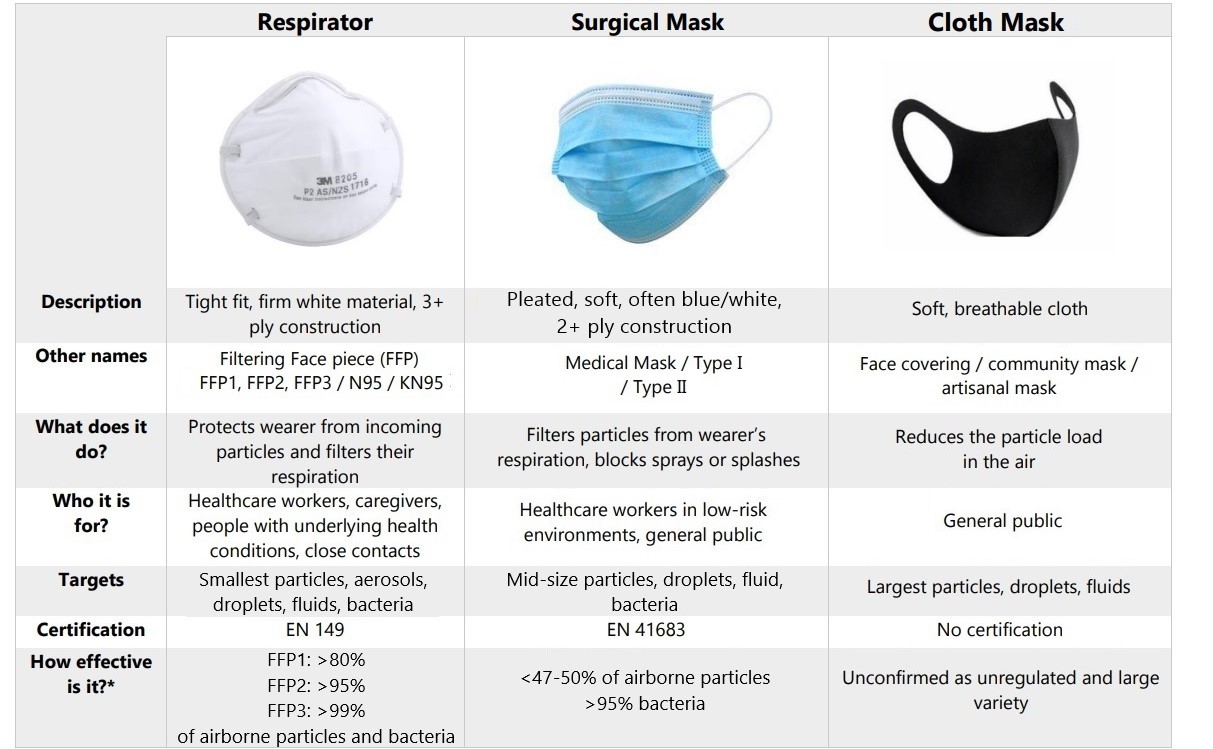Clinical Grade Masks and Respirators: A Guide for COVID-19 Protection

New guidance has recently been released by the HSE and Irish government recommending the use of an FFP2 or FFP3 ‘respirator’ rather than a ‘mask’, particularly for:
- Healthcare, nursing home, and care workers
- Those with or suspected of having Covid-19
- Those at high risk of developing complications from Covid-19
- Close contacts, isolating or otherwise
With the highly contagious Omicron variant, increased focus is being placed on securing the highest quality protection. But all these acronyms and numbers can be confusing – not to mention the variety of synonyms and international terminology. This post explores the protection available, giving an overview of the key differences within medical-grade respirators.
The table below compares 3 common types of face covering, and can be used to understand key differences in their performance and intended use.
 * Statistics from the American Society for Microbiology
* Statistics from the American Society for Microbiology
As has been extensively studied in the previous 2 years, Covid-19 spreads via airborne particles. A mask traps the particles from our breath in its material, hence reducing the overall particle load in the air.
Surgical masks and respirators offer the highest protection, plus the peace of mind from a certified PPE product. In the early days of the pandemic, shortages of respirators meant they were reserved for healthcare professionals, and so cloth masks were a viable option for the general public. With increased supply of both respirators and surgical masks, these higher-quality options are now more available and affordable. And if a larger portion of the general public wear high-quality masks then there will be a greater chance of protection.
Respirators
Three or more layers of synthetic material create physical and electrostatic barriers that attract and trap particles, preventing them from entering or leaving the respirator. They filter at least 80% of particles (for an FFP1), but more commonly 95%+ particles, which are called FFP2.
FFP2 vs N95 vs KN95
In Europe respirators are controlled by EN Certification 149, which assigns their FFP1, FFP2, or FFP3 status based on their filtration ability. The US equivalent of the FFP2 is the N95. In China, these are known as KN95.
Valved vs Non-Valved
Valved respirators do not filter exhalation so they are recommended for use when the focus is on protecting the wearer. For example, if contacting or caring for someone with suspected or confirmed Covid-19. The HSE does not recommend the use of respirators with valves unless in the above situation.
Non-Valved respirators filter respiration, so should be worn if the focus is to protect those around the wearer. For example, close contacts or those suspected of infection.
Surgical masks
Surgical masks are designed as a physical barrier for bacteria, respiration and moisture from the wearer, to protect a patient. Their airborne particle filtration is typically between 47-50%. Although this is lower than a respirator, they are 95% effective at blocking bacteria, sneezes, coughs, moisture and droplets, so are still a helpful and protective mask in the context of this pandemic.
If there is no heightened health risk then the HSE recommends the use of surgical masks. There are different ‘types’ of surgical mask, determined by the standard EN 14683. Type I masks have a slightly lower bacterial filtration standard (95%) than Type II (98%).
The Right Fit
A mask should fit snugly over the nose, mouth, and chin for optimal protection. Gaps at the side or underneath can create leakage, which significantly undermines their performance.
Respirators must fit tightly on the face in order to work correctly, and usually a fit-test is required when worn for work. Achieving an effective fit can pose problems for people with facial hair or medical conditions that can make breathing through the barrier difficult, and should be evaluated for the individual’s needs. Mask-extenders attach to the straps and connect around the back of the head. They can provide a solution for uncomfortable tightness or pressure on the ears and can help with a closer fit on the cheeks.
High-quality surgical masks have nose pieces that allow you to shape them to fit closely. And to improve the overall fit, the ‘knot and fold’ technique has become popularised, and has been shown by the CDC to increase the efficacy of a surgical mask to up to 64%.

Image Credit: Centre for Disease Control (CDC)






